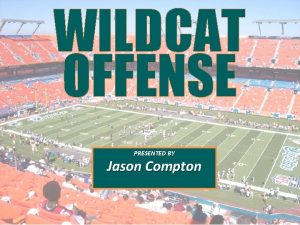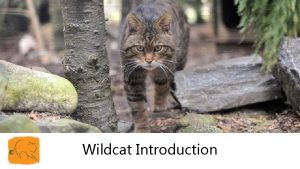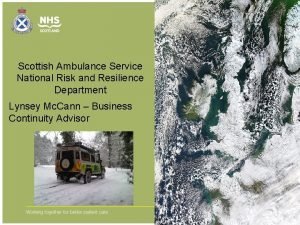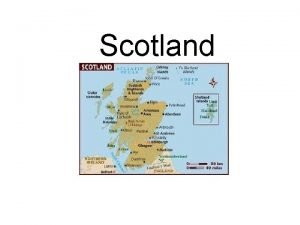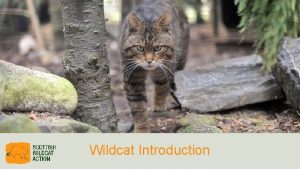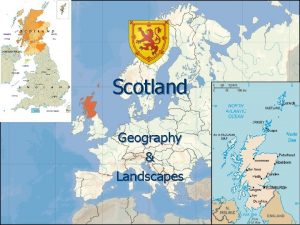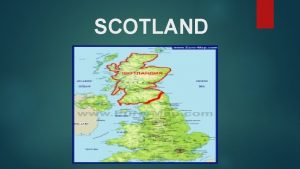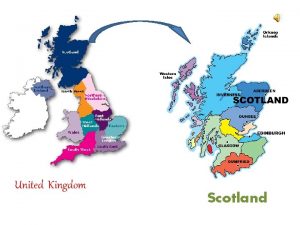Wildcat Introduction What is a Wildcat in Scotland















- Slides: 15

Wildcat Introduction

What is a Wildcat in Scotland? • The wildcat (Felis silvestris) is Britain’s last native cat species • They are very well adapted to life in the mountains • The wildcat plays an important role in a healthy ecosystem • They look similar to a large pet cat however, there are key differences • Sadly, they are now one of our most endangered mammals and are on the edge of extinction A wildcat call A wildcat growl

In mythology • Fables of the Cat Sìth, a fairy creature, thought to have been inspired by the Kellas cat. • In 1693 it was mentioned how body parts of the wildcat were used for medicinal purposes; • its flesh for treating gout, its fat for dissolving tumours and easing pain, its blood for curing "falling sickness", and its excrement for treating baldness.

In heraldry the Wildcat Is considered an icon of Scottish wilderness, and has been used in clan heraldry since the 13 th century. • The Picts honored wildcats, probably named Caithness (Land of the Cats) after them. • The foundation myth of the Catti tribe is based upon the wildcat. • The wildcat’s ferocity impressed the Catti so much, that it became their symbol. • The Clan Sutherland chief bears the title Morair Chat (Great Man of the Cats). • The Clan Chattan Association (aka the Clan of Cats) comprises 12 clans, the majority of which display the wildcat on their badges. Clan Chattan Crest of Clan Sutherland

Wildcat Status in Scotland • Wildcats in Scotland are Critically Endangered • From a functional perspective this population is extinct or on the brink of extinction • Less than 115 individuals left in the wild • The Scottish wildcat would become extinct without help The population of wildcats in Scotland is estimated to be below 100

The story so far… 55 BC 7, 000 BC European wildcats crossed the ice from the Continent into Britain at the end of the last Ice Age, 9, 000 years ago The Romans bring Near Eastern cats to Britain as pets 1880 – 1890 AD No wildcats left in England or Wales 2015 AD Scottish Wildcat Action brings together the UK’s top wildcat experts in a bid to save this locally critically endangered native species. It is the first national conservation plan with a vision to restore viable populations of wildcats within the central Highlands. 1915 – 1980 AD After the World Wars, Scottish wildcats start to range further afield and meet mostly pet cats 2013 AD The Scottish Wildcat Conservation Action Plan is developed 1988 AD Wildcats are legally protected for the first time, it is now illegal to kill or disturb a wildcat

Cause of the decline Hybridisation Persecution Disease Habitat change Prey decline

How to spot a wildcat Wildcat 4 wavy neck stripes 2 shoulder stripes Unbroken stripes on the side No spots on bottom Back stripe stops at tail Dark tail stripes Tip is rounded and black Domestic / Pet cat Here are the 7 main distinguishing features:

Wildcat kittens

Wildcat Pet cat Hybrid kittens

Wildcat Priority Areas Strathpeffer Northern Strathspey Morvern Strathavon Strathbogie Angus Glens Scottish Wildcat Action are creating safe places for wildcats in these six priority areas.

Wildcat Habitat Scotland has been heavily deforested which caused the wildcat to evolve to use different types of habitat: o Farmland o Meadows o Forest o Mountain Foothills

Conservation in Action Scottish Wildcat Action are: • Working in the priority areas to reduce the risks of hybridisation, disease and accidental persecution • Breeding healthy wildcats for later release to increase the population • Gathering data and sharing the findings to improve understanding of this elusive predator

Camera Traps

How you can help • Report sightings of wildcat • Make sure your cat is a Supercat! • Supercats are pet or farm cats that have been micro-chipped, neutered and have up-to-date vaccinations. http: //www. scottishwildcataction. org/
 Youth wildcat offense
Youth wildcat offense Wildcat football plays
Wildcat football plays Fvsu wildcat card
Fvsu wildcat card Hybrid scottish wildcat
Hybrid scottish wildcat Wildcat youth hockey
Wildcat youth hockey Wildcat
Wildcat Escocia en ingles
Escocia en ingles Wisconsin in scotland
Wisconsin in scotland Scotland is situated
Scotland is situated Medical and dental defence union of scotland
Medical and dental defence union of scotland National risk and resilience unit scotland
National risk and resilience unit scotland Positive impacts of tourism in scotland
Positive impacts of tourism in scotland Is scotland a country
Is scotland a country Into what parts is scotland divided geographically
Into what parts is scotland divided geographically Sbar tool
Sbar tool Pews chart 1-4
Pews chart 1-4
